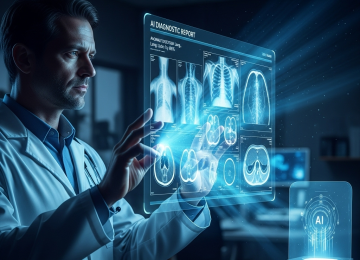Decoding Artificial Intelligence: 7 Essential Insights
The term “Artificial Intelligence” has transcended niche tech circles to become a dominant topic of global conversation. From revolutionizing industries to altering our daily routines, the impact of AI is both profound and rapidly accelerating. But what does it truly mean? Far more than just sentient robots from science fiction, **Artificial Intelligence** is a vast and complex field centered on creating systems that can perform tasks that typically require human intelligence. This article will demystify the technology, offering seven essential insights into how AI is actively shaping our present and future.
Understanding AI begins with its core components. At its heart, modern AI is driven by machine learning (ML), a subset where algorithms are trained on vast datasets to recognize patterns and make predictions. A further specialization, deep learning, utilizes complex neural networks with many layers to process data in a more sophisticated manner, mimicking the structure of the human brain. These technologies are the engine behind the incredible advancements we see today, from voice assistants understanding our commands to sophisticated systems that can compose music or write code.

Defining the Core of Artificial Intelligence
Before diving into its applications, it’s crucial to establish a foundational understanding of what Artificial Intelligence encompasses. At its most basic level, AI refers to the simulation of human intelligence in machines, programmed to think, learn, and problem-solve. This is often categorized into two main types: Narrow AI and General AI.
**Narrow AI (or Weak AI):** This is the type of AI we interact with every day. It is designed and trained for one specific task. Examples include Apple’s Siri, Amazon’s Alexa, facial recognition software, and the recommendation algorithms on Netflix and Spotify. While incredibly powerful within its specific domain, Narrow AI operates under a limited, pre-defined set of constraints and cannot perform tasks outside its scope.
**Artificial General Intelligence (AGI or Strong AI):** This is the more futuristic concept of AI often depicted in media. AGI would possess the ability to understand, learn, and apply its intelligence to solve any problem, much like a human being. It would have consciousness, self-awareness, and the ability to transfer knowledge from one domain to another. Currently, AGI remains a theoretical goal and a subject of intense research and debate within the tech community. As we explore the real-world impact of AI, it’s important to remember that all current applications fall under the umbrella of Narrow AI. For more information on breakthrough technologies, you can explore our related article on quantum computing.
The 7 Key Ways AI is Reshaping Our World
The practical applications of AI are no longer theoretical; they are integrated into the fabric of modern society. Here are seven key areas where its influence is undeniable.
1. **Revolutionizing Healthcare:** AI algorithms can analyze medical images like X-rays and MRIs with a high degree of accuracy, often detecting diseases like cancer earlier than the human eye. It also accelerates drug discovery by modeling complex biological interactions.
2. **Hyper-Personalized Entertainment:** The content you see on streaming services and social media is curated by sophisticated AI. These systems analyze your viewing habits to recommend movies, shows, and music tailored specifically to your tastes.
3. **Smarter Business Operations:** From supply chain management to customer service, AI is optimizing business processes. AI-powered chatbots handle customer inquiries 24/7, while predictive analytics help companies forecast demand and manage inventory efficiently.
4. **Advancements in Autonomous Systems:** The automotive industry is a prime example of AI in action. Features like advanced driver-assistance systems (ADAS) and the development of fully autonomous vehicles rely heavily on AI to perceive the environment and make real-time decisions.
5. **Enhanced Cybersecurity:** As cyber threats grow more sophisticated, AI is becoming an essential line of defense. It can identify patterns indicative of a cyberattack in real-time, detecting anomalies and neutralizing threats faster than human teams can.
6. **The Rise of Generative AI:** Tools like ChatGPT and DALL-E 2 have brought the power of generative AI to the masses. These models can create original text, images, and code from simple prompts, opening new frontiers for content creation and creative expression.
7. **Optimizing Financial Markets:** In finance, AI algorithms execute high-frequency trades based on market predictions and are instrumental in detecting fraudulent transactions by identifying unusual spending patterns.

Looking Ahead: The Future of Artificial Intelligence
The trajectory of **Artificial Intelligence** points toward even deeper integration into our lives. Experts anticipate significant progress in areas like natural language understanding, allowing for more seamless human-computer interaction. The development of ethical frameworks and regulations will be critical to ensure responsible deployment, a topic closely watched by governments and organizations worldwide. As reported by leading news outlets, the global conversation around AI governance is intensifying, with many nations aiming to establish standards for its use. You can read more about these global tech developments on authority sites like Reuters Technology.
The future of the job market is another area of intense discussion. While AI-driven automation will inevitably displace certain roles, it is also expected to create new jobs that require skills in AI development, management, and ethics. The focus will shift from repetitive tasks to roles that emphasize creativity, critical thinking, and emotional intelligence—qualities that remain uniquely human. Ultimately, the future of AI will be shaped not just by technological breakthroughs but by the societal choices we make regarding its implementation and control.
In conclusion, Artificial Intelligence is a transformative force with the power to solve some of the world’s most complex problems. By understanding its core principles and observing its current applications, we can better prepare for the innovations that lie ahead and engage thoughtfully in the conversation about its role in our shared future.













